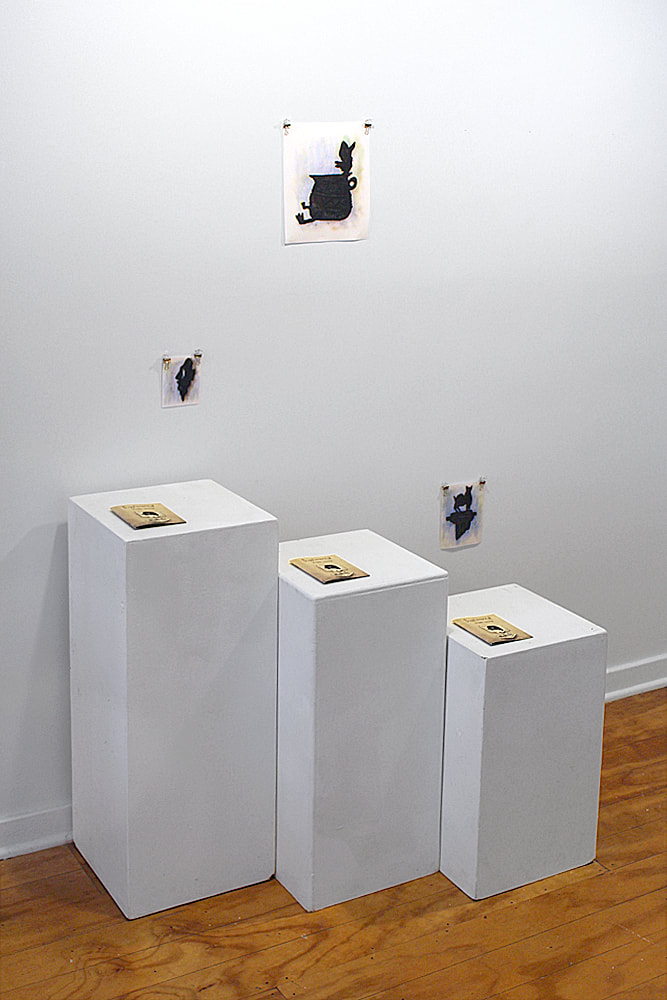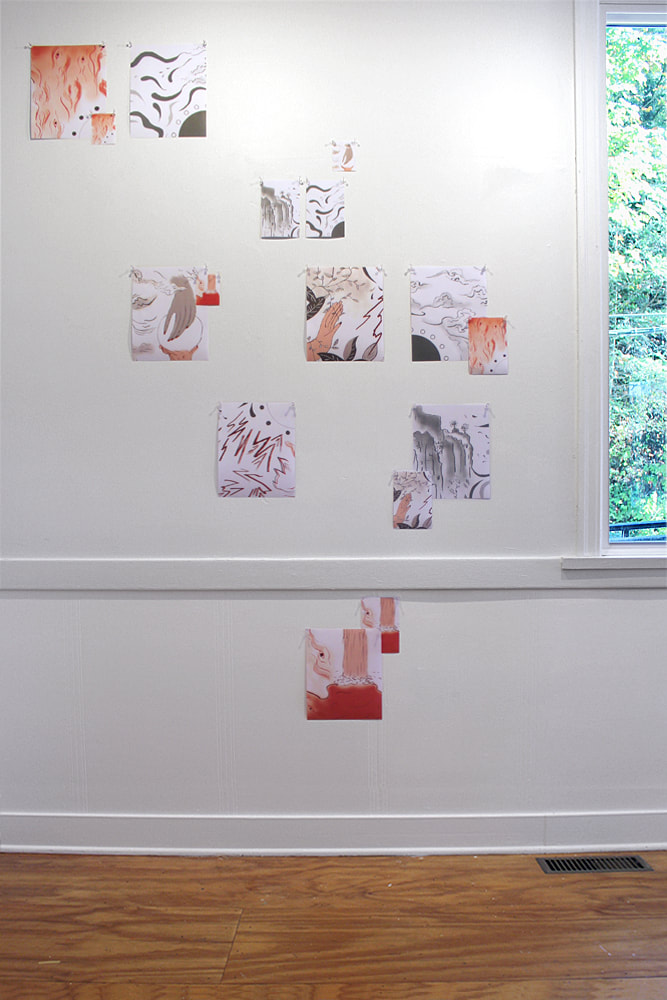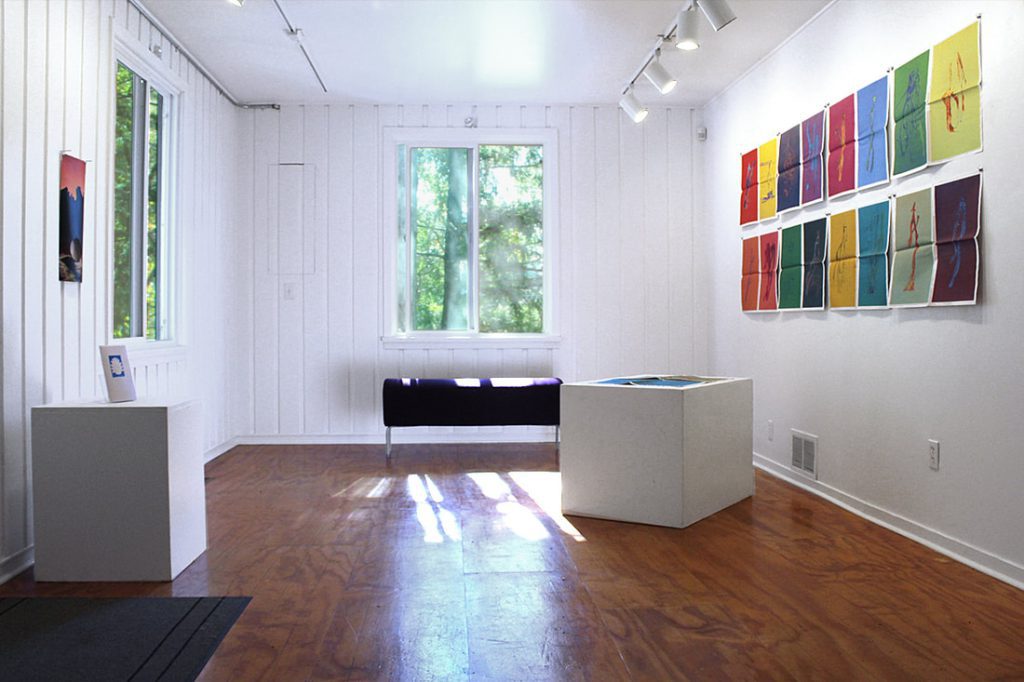Duality Paradox: A Group Zine Exhibition at Ranger Station Gallery
27 January 2022
By Courtney Miller
On a wet and windy afternoon, I followed the road wrapping the southeast shoreline of Harrison Lake in Harrison Hot Springs, BC, to reach the Ranger Station Gallery. Situated on unceded Sts’ailes territory, in a touristy village 131 kilometres east of Vancouver, the gallery is on the periphery of the West Coast art scene. The combined exhibition and artist residency space is perched just above the lake, where you can see wobbling boats and the strip of shorefront businesses through the windows.
Duality Paradox was a group exhibition featuring artists Alanna Irene Edwards, Manuel Axel Strain, Nathan Jones, Rachel Lau, and Russell Leng. The show caught my attention for several reasons: firstly, experimental and thematically conceptual exhibitions are fairly uncommon this far out in the Fraser Valley, mainly since regional gallery scenes in Canada tend towards more representational art. I was also interested in the new curatorial collaboration between artists Aaron Moran and Sylvana dAngelo, who had previously organized the interactive zine exhibition, Bibliocache, for the Vancouver Art Book Fair (VBAF) program in 2019. Bibliocache was “an experimental library of self-published projects,”1 featuring artists whose practices may or may not include books, thus expanding the possibilities for artist publications, experimental print works, zines, and beyond. As individuals, the curators also support zinemaking in similar capacities to one another. dAngelo was artistic director of the VABF from 2017 to 2020, and organized Zine Club from 2013 to 2019. Moran is the creator behind Poor Quality, a zine, print, art, and text initiative. This being considered, Duality Paradox was an ambitious feat, since the small group of artists responded to a scientific concept in a two-part exhibition (at the Ranger Station Gallery and online), outside of a typical metropolitan location, all while happening amidst the global pandemic.
The exhibition provided a playful tension between the DIY aesthetic of zines and formal curatorial installation in a gallery space. Zinemaking is accompanied by a legacy of subversive discourse as an outlet for personal experiences and obscure topics, and in this exhibition, zines rightfully received proper treatment as art objects. Typically, zines are created using basic quality paper and standard printing methods, allowing for a more affordable approach to making, distributing, and owning art. A viewer’s encounter with a zine usually involves holding the book and flipping through each page, but with the COVID-19 pandemic, high-touch points presented potential for viral transmission. In Duality Paradox, the handling of zines was modified by displaying many of the print works as page-by-page arrangements on the walls. For viewers who could not attend in person, there was the robust online component to reference.
The curators prompted artists to respond to a facet of wave-particle theory called the “duality paradox,” wherein the same object will exhibit different characteristics based on its environment. Prior to wave-particle theory, an object was thought to be composed of either wave or particle characteristics, and should behave the same in different settings. Yet, in quantum mechanics, an object is contradictory in that it can be both particle and wave depending on its setting.2 The artists interpreted this thematic paradox through their works, offering their impressions of contradictory and complementary personal experiences. The premise of the exhibition explored the duality and contradictions of ‘high’ and ‘low’ art in relation to zines in a gallery space, and of particle and wave theory in relation to the artist’s individual realities.

Installed using push pins and a mid-height plinth, Nathan Jones’ zine, Supplemental: Private Viewing (2017), gave a surreal peek into imaginary gallery and studio spaces. The title points to an invitation-only preview of an exhibition, where artworks are often up for sale. The hanging prints depicted silhouettes of sculptural artworks pinned at varying heights. The illustrated artworks in the zine were repeatedly positioned in relation to a shadow image of themselves: they appeared as blank figurative forms stacked on plinths, or paintings within paintings. Some of the illustrations depicted sculptures wilting or peeling in a palpable heat. I noted overlaps between Jones’ commentaries on the commercial art world, drawing attention to the act of viewing, and to those of Alanna Irene Edwards’ work nearby.
Like Private Viewing, Alanna Irene Edwards’ Wanted (2019) addressed the environment of private art collections and sales. Similarly installed as a book on a plinth and a print pinned to the wall, the imagery was composed of pages taken from commercial Indigenous art magazines, such as American Indian Art Magazine and Native Peoples Magazine, as well as older anthropological books. In their original forms, the magazines proved their settler colonial-centred mindset, promoting acquisition of Indigenous artworks and cultural objects by non-Indigenous art collectors or institutions. As an artist of Mi’kmaq and settler ancestry, Edwards uses her practice to respond to how Indigenous people are looked at in various forms of media. After reproducing the magazine pages, she cut and removed images of all Indigenous people and art objects, leaving empty outlines on the page. The print pinned to the wall depicted what appeared to be a dramatic southwestern sunset and a hole where a clay pot once sat atop a rock formation. By cutting and removing these photographs of objects and people, the subjects were no longer available for viewable consumption. Left with the absence of particular imagery, the viewer is forced to question the weight of a colonial visual desire.
Artist Manuel Axel Strain echoed Edwards’ narrative alteration in their work, Smudging the English Dictionary (2020). Located on a small digital TV screen on the back wall of the gallery, an image of an open dictionary with a previously lit bundle of sage nestled between the pages was displayed. The entries on the book’s facing pages began with incubate and ended with India, continuing with suffix –n. On a foundation of personal, intergenerational and political experiences, Strain (who is of Musqueam/Simpcw/Syilx ancestry) linked acts of remembering with methods of remedy. The weighty presence of the English tome suggested the burden of an imposed European language system, and yet despite its heaviness, the lexicon represents only one kind of knowledge. The artist’s family and ancestors have passed down a more comprehensive epistemology, indicated by the smudge stick over the book.3 Reckoning with these heavy colonial histories, Strain’s gesture of smudging the dictionary shifted past and present narratives to create a space for dialogue and healing.

Across the gallery from Strain’s work was Rachel Lau’s change with me / 天地人和我 (2020), consisting of a deconstructed zine pinned to the wall in varying print sizes, which trailed downward and around a corner. The installation was situated next to a window that looked out at the winding lakeshore road. The illustrated narrative suggested a process of personal transformation by moving through different elemental environments of earth, air, water, and fire. The work was inspired by the I Ching (Book of Changes), and depicted representations of opposing forces in the universe, “invit[ing] you to contemplate and embrace the changes afoot in these insurgent times.”4 In various tones of grey, red and brown, the swirling clouds and many-eyed mists enveloped outstretched hands amongst amorphous energies. These forms were followed by circular slices, and distant cliff faces and tumbling waterfalls unfolded in a tumbling series of events. The illustrations presented the viewer with a multifaceted visual perspective, rather than from a single viewpoint, pushing this arrangement to break away from the typical beginning-middle-end format of a book, thus proposing that change is not a linear process.
Similarly, a process of change can also be a process of revelation. Russell Leng is an artist who typically works in painting, but his work for Duality Paradox, titled Crack Sealing (2019) was comprised of digital prints on newsprint paper pinned to the wall and laid out on a low plinth. As organic forms in inorganic colours, the representations of cracks looked like interconnected waterways, or fibrous networks under a microscope. These forms are a pared-down take on the artist’s typical multilayered mark making, by simply printing carve-like “cracking” designs on solid bright backgrounds. His creative approach is enacted through “searching practices such as metal-detecting, rescue missions, and archaeological field work.”5 Within this vein of interest, Crack Sealing suggested actions of sampling and repairing, as each print acted like a snapshot documentation of a filled-in gouge with contrasting colours in the background. The arrangement of prints was such that it suggested the artist had recently completed fieldwork and was demonstrating evidence of his findings.

Each artist’s response to the concept of the duality paradox contained facets of their lived experiences, while simultaneously presenting unexpected overlapping similarities between each other. The curators successfully fostered the artist’s creative interrelationships both at Ranger Station Gallery and the online exhibition, giving equal attention to developing each space. While the physical exhibition has since ended and the drive out to Harrison Hot Springs was part of Duality Paradox’s more peripheral context, the online component of the exhibition remains an immersive experience in its own right. The virtual space continues to make all of the works viewable in their entirety on a single page, giving the visitor the ability to reimagine a sort of digital collage in their mind’s eye. This notion echoes the curators’ programming at Ranger Station Gallery, where the curators also hosted a physically distanced zinemaking workshop. Accepting the challenges of exhibiting during a pandemic, dAngelo, Moran and the artists created playful and responsible adaptations of DIY, zine-aesthetics, stretching the typical boundaries of an art exhibition akin to thematic quantum theory.
- “Bibliocache,” Poor Quality, https://poorquality.ca/filter/evan-brien/BIBLIOCACHE.
- “Duality Paradox,” Particle + Wave: Research into similarity, http://www.particle-wave.space/particle/.
- Manuel Axel Strain, https://www.manuelaxelstrain.com/.
- Rachel Lau, “Change With Me,” https://www.racholau.com/change-with-me.
- “Temporary Tunnels,” Field Contemporary, http://www.field-contemporary.com/temporary-tunnels-russell-leng.html.
Duality Paradox ran from October 10 – November 1, 2020 at Ranger Station Gallery in Harrison Hot Springs, BC, and continues online at particle-wave.space.exhibition
Feature Image: Installation view of Duality Paradox. Photo by Aaron Moran.



